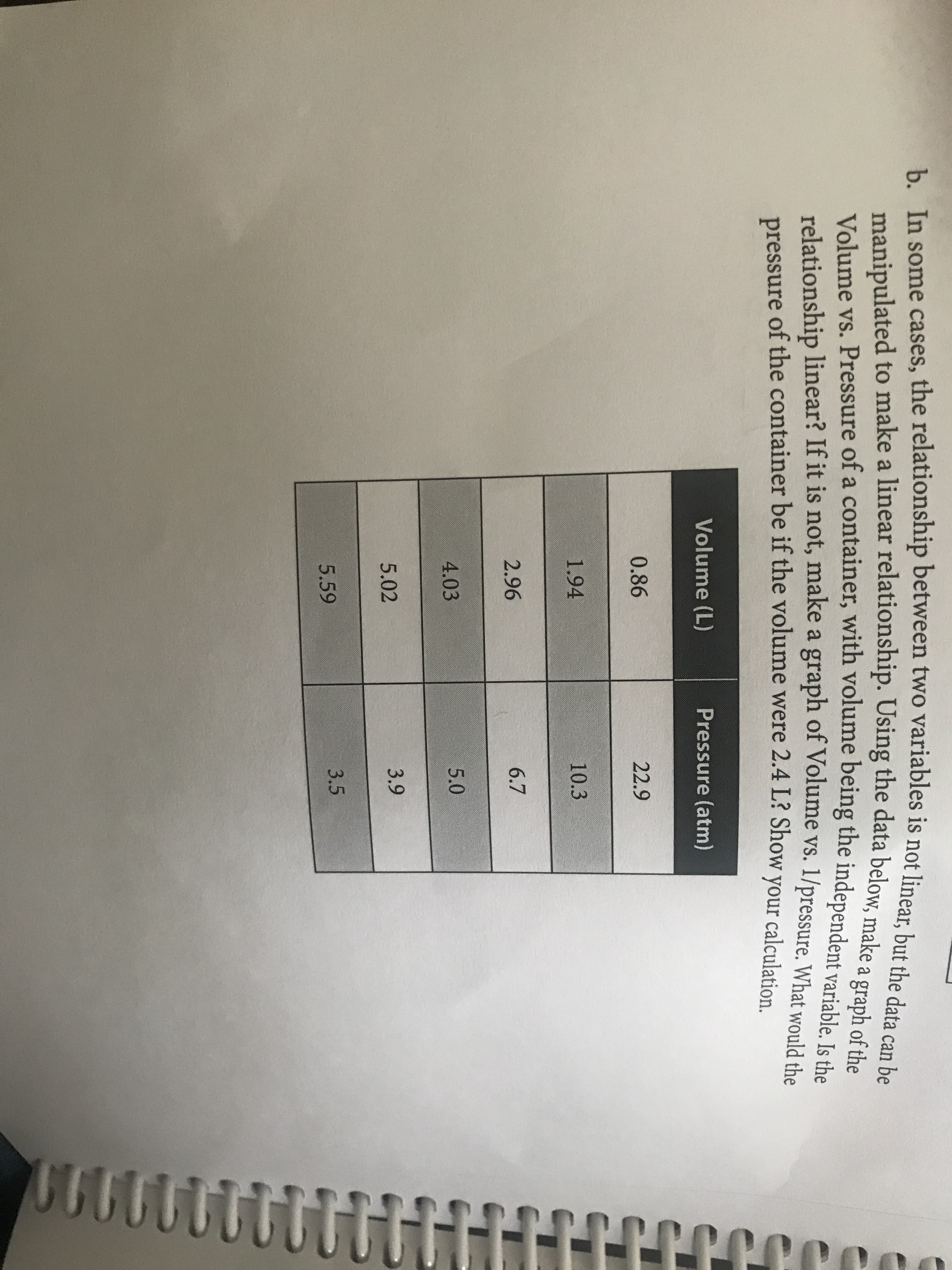b. In some cases, the relationship between two variables is not linear, but the data can be manipulated to make a linear relationship. Using the data below, make a graph of the Volume vs. Pressure of a container, with volume being the independent variable. Is the relationship linear? If it is not, make a graph of Volume vs. 1/pressure. What would the pressure of the container be if the volume were 2.4 L? Show your calculation Volume (L) Pressure (atm) 0.86 22.9 1.94 10.3 2.96 6.7 4.03 5.0 5.02 3.9 3.5 5.59
b. In some cases, the relationship between two variables is not linear, but the data can be manipulated to make a linear relationship. Using the data below, make a graph of the Volume vs. Pressure of a container, with volume being the independent variable. Is the relationship linear? If it is not, make a graph of Volume vs. 1/pressure. What would the pressure of the container be if the volume were 2.4 L? Show your calculation Volume (L) Pressure (atm) 0.86 22.9 1.94 10.3 2.96 6.7 4.03 5.0 5.02 3.9 3.5 5.59
Principles of Modern Chemistry
8th Edition
ISBN:9781305079113
Author:David W. Oxtoby, H. Pat Gillis, Laurie J. Butler
Publisher:David W. Oxtoby, H. Pat Gillis, Laurie J. Butler
Chapter9: The Gaseous State
Section: Chapter Questions
Problem 24P
Related questions
Question
I don't know where to start.

Transcribed Image Text:b. In some cases, the relationship between two variables is not linear, but the data can be
manipulated to make a linear relationship. Using the data below, make a graph of the
Volume vs. Pressure of a container, with volume being the independent variable. Is the
relationship linear? If it is not, make a graph of Volume vs. 1/pressure. What would the
pressure of the container be if the volume were 2.4 L? Show your calculation
Volume (L)
Pressure (atm)
0.86
22.9
1.94
10.3
2.96
6.7
4.03
5.0
5.02
3.9
3.5
5.59
Expert Solution
This question has been solved!
Explore an expertly crafted, step-by-step solution for a thorough understanding of key concepts.
This is a popular solution!
Trending now
This is a popular solution!
Step by step
Solved in 3 steps with 3 images

Knowledge Booster
Learn more about
Need a deep-dive on the concept behind this application? Look no further. Learn more about this topic, chemistry and related others by exploring similar questions and additional content below.Recommended textbooks for you

Principles of Modern Chemistry
Chemistry
ISBN:
9781305079113
Author:
David W. Oxtoby, H. Pat Gillis, Laurie J. Butler
Publisher:
Cengage Learning

General Chemistry - Standalone book (MindTap Cour…
Chemistry
ISBN:
9781305580343
Author:
Steven D. Gammon, Ebbing, Darrell Ebbing, Steven D., Darrell; Gammon, Darrell Ebbing; Steven D. Gammon, Darrell D.; Gammon, Ebbing; Steven D. Gammon; Darrell
Publisher:
Cengage Learning

Introductory Chemistry: A Foundation
Chemistry
ISBN:
9781337399425
Author:
Steven S. Zumdahl, Donald J. DeCoste
Publisher:
Cengage Learning

Principles of Modern Chemistry
Chemistry
ISBN:
9781305079113
Author:
David W. Oxtoby, H. Pat Gillis, Laurie J. Butler
Publisher:
Cengage Learning

General Chemistry - Standalone book (MindTap Cour…
Chemistry
ISBN:
9781305580343
Author:
Steven D. Gammon, Ebbing, Darrell Ebbing, Steven D., Darrell; Gammon, Darrell Ebbing; Steven D. Gammon, Darrell D.; Gammon, Ebbing; Steven D. Gammon; Darrell
Publisher:
Cengage Learning

Introductory Chemistry: A Foundation
Chemistry
ISBN:
9781337399425
Author:
Steven S. Zumdahl, Donald J. DeCoste
Publisher:
Cengage Learning

Physical Chemistry
Chemistry
ISBN:
9781133958437
Author:
Ball, David W. (david Warren), BAER, Tomas
Publisher:
Wadsworth Cengage Learning,

Chemistry: Principles and Reactions
Chemistry
ISBN:
9781305079373
Author:
William L. Masterton, Cecile N. Hurley
Publisher:
Cengage Learning

Chemistry: Matter and Change
Chemistry
ISBN:
9780078746376
Author:
Dinah Zike, Laurel Dingrando, Nicholas Hainen, Cheryl Wistrom
Publisher:
Glencoe/McGraw-Hill School Pub Co